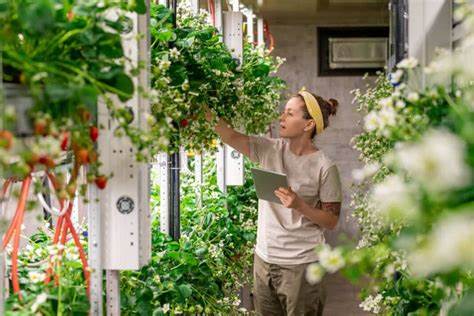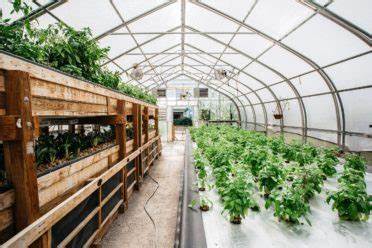
Vertical Farming: Optimizing Pest and Disease Management for Sustainable Crop Production
Introduction
Vertical farming has gained immense popularity in recent years as a revolutionary agricultural practice. This innovative method involves growing crops in vertically stacked layers using controlled environments such as indoor farms or high-tech greenhouses. However, the success of vertical farming heavily relies on effective pest and disease management. This article explores the importance of pest and disease management in vertical farming and its potential impact on crop yield and quality.
Historical Background
The concept of vertical farming can be traced back to the Hanging Gardens of Babylon, one of the Seven Wonders of the Ancient World. However, modern vertical farming began to take shape in the early 20th century with the invention of hydroponics and techniques for growing plants without soil. As vertical farming gained traction, the need for effective pest and disease management practices became evident to ensure optimal crop growth and productivity.
Key Concepts and Definitions
Integrated Pest Management (IPM) is a crucial concept in vertical farming. It involves the use of a combination of techniques and strategies to manage pests and diseases in a sustainable and environmentally friendly manner. Biosecurity, another key term, refers to measures taken to prevent the introduction and spread of pests and diseases in a farming system. Disease resistance, on the other hand, refers to the ability of plants to resist or tolerate diseases. Monitoring and prevention play a vital role in pest and disease management, allowing timely interventions to prevent widespread damage.

Main Discussion Points
Integrated Pest Management (IPM)
IPM is of paramount importance in vertical farming. Its principles revolve around using a holistic approach to pest and disease management. Cultural control methods, such as crop rotation and sanitation practices, can help disrupt pest life cycles and reduce disease transmission. Physical control methods, like the use of nets and barriers, can physically prevent pests from entering the farming system. Biological control methods involve the use of natural enemies, such as predatory insects or beneficial bacteria, to control pests. Chemical control methods, when necessary, should be used judiciously and in accordance with strict regulations to minimize environmental impact.
Disease Management Strategies
Vertical farming crops are susceptible to various diseases, including fungal, bacterial, and viral infections. Preventive measures such as maintaining strict sanitation protocols, practicing crop rotation, and implementing quarantine protocols for new plants can significantly reduce disease incidence. Additionally, the use of disease-resistant cultivars or genetically modified crops can provide an added layer of protection against diseases.
Pest Management Strategies
Common pests, such as aphids, mites, and whiteflies, can pose a significant threat to vertical farming systems. Effective pest identification and monitoring play a crucial role in early detection and intervention. Integrated pest management techniques, such as the introduction of predatory insects or beneficial bacteria, can help control pest populations without relying heavily on chemical pesticides.

Case Studies or Examples
Several successful vertical farming operations have showcased effective pest and disease management strategies. For instance, Gotham Greens, a leading urban agriculture company, utilizes a combination of IPM techniques, including biological control agents and strict sanitation practices, to manage pests and diseases in their vertical farms. In another example, AeroFarms, a vertical farm in New Jersey, leverages data analytics and machine learning algorithms to optimize pest and disease management strategies, resulting in higher crop yields and improved plant health.
Current Trends or Developments
Ongoing research in pest and disease management in vertical farming has yielded promising results. Researchers are exploring new technologies and innovations, such as sensor-based monitoring systems and automated control methods, to enhance pest and disease detection and control. Harnessing the power of data analytics and machine learning algorithms can enable real-time monitoring and predictive analysis, leading to more efficient pest and disease management practices.
Challenges or Controversies
Despite its numerous benefits, pest and disease management in vertical farming faces challenges and controversies. Pesticide resistance is a growing concern, as pests can develop resistance to chemical control methods over time. Additionally, the potential environmental impact of chemical pesticides raises concerns about sustainable farming practices. The use of genetically modified crops to enhance disease resistance also remains a topic of debate, as some consumers express concerns about the long-term effects on human health and biodiversity.

Future Outlook
The future of pest and disease management in vertical farming looks promising. Advancements in automation and robotics are expected to revolutionize the efficiency of pest and disease control. The integration of artificial intelligence and machine learning algorithms can enable real-time monitoring, rapid decision-making, and precise application of control measures. Furthermore, with the looming threats of climate change, understanding pest and disease dynamics in vertical farming systems will be crucial to ensure resilient and sustainable crop production.
Conclusion
Effective pest and disease management is vital for the success and sustainability of vertical farming. Integrated Pest Management (IPM), disease-resistant cultivars, and biological control methods offer practical solutions for minimizing the impact of pests and diseases. Ongoing research and collaboration are essential to further enhance pest and disease management strategies in vertical farming. By prioritizing pest and disease management, we can ensure a resilient and sustainable future for crop production in vertical farming systems.
References
Smith, H. A. (2019). Vertical Farming: Sustainable Agriculture for the Future. Cambridge University Press.
Lamont, W. J. (2020). Controlled Environment Vertical Farming: Innovations in Horticultural Science. Academic Press.
Gotham Greens. (n.d.). Retrieved from https://www.gothamgreens.com/
AeroFarms. (n.d.). Retrieved from https://aerofarms.com/




